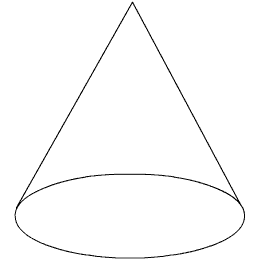Pyramids and Cones
In the last section, we learned about prisms and cylinders. We defined prisms as three-dimensional figures with two bases that have the same size and shape and are parallel to each other. We learned how to take the prisms and lay them out flat to see the various sides and their dimensions.
In this section, we are going to study pyramids and cones. Instead of having two bases, pyramids and cones have just one base and the edges extending from that base extend up to one point (point P in the figure below). It is important that you can draw these figures out flat as well. This will help when calculating the surface area.
Example:
What do the sides of this pyramid look like when it is laid out flat?
 |
Pyramid |
Solution:
The base of the pyramid is a quadrilateral and all of the sides are triangles. For our purposes, the base of the pyramids will always be regular, in this case, a square.

|
Sides of the pyramid |
Example:
What do the sides of this cone look like when it is laid out flat?
 |
Cone |
Solution:
The base of the cone is a circle and the side is a segment of a circle.
 |
Side of the cone |